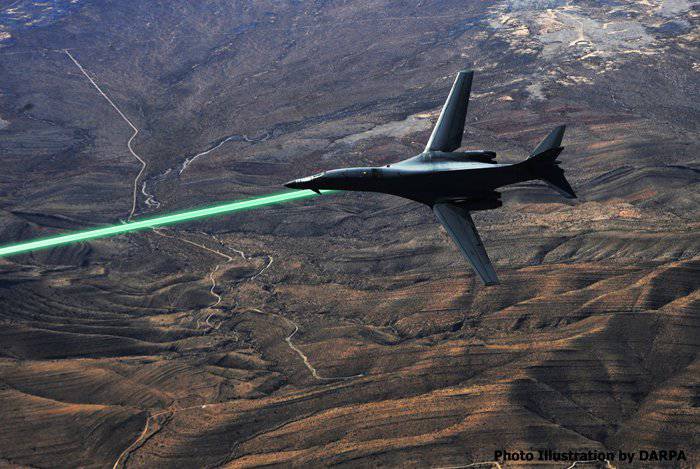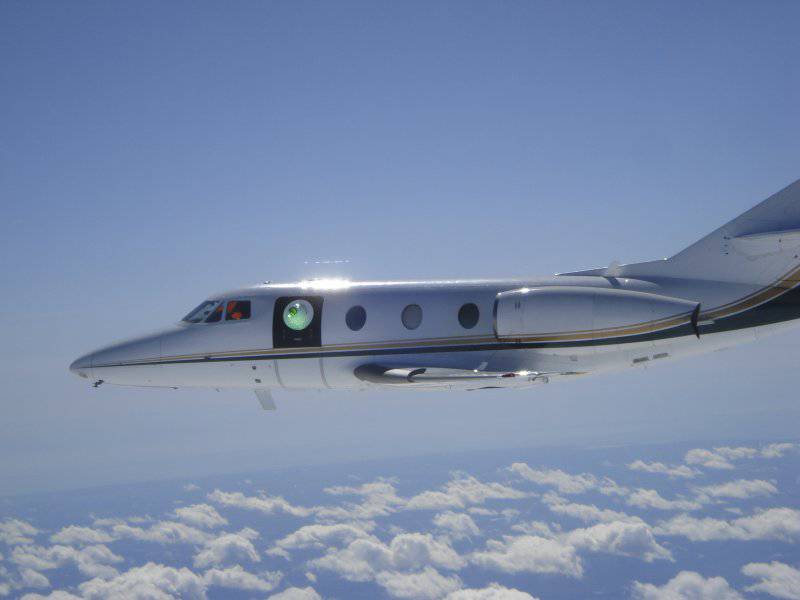In the United States are developing lasers that can protect the aircraft from the rear hemisphere
On board the experimental aircraft was installed a new laser gun, which received the designation Aero-adaptive Aero-optic Beam Control (ABC). This setup allows you to direct the laser beam at almost any angle. In the future, such an installation can be used to intercept missiles flying both above and below the aircraft, as well as behind the aircraft.
Software and optical stabilization system, created by engineers at Lockheed Martin, can compensate for the effect of turbulence, which occurs due to the fact that the combat part of the laser system protrudes from the aircraft fuselage. According to Doug Graham, who holds the post of vice president for promising programs of the company, the first tests of the laser turret allow us to speak with confidence about the viability of the proposed development and its existing potential.
At one time, some models of bombers, as well as military transport aircraft aviation received fodder cannon mounts, which were used to provide effective protection against enemy fighter aircraft. It can be noted that such a defensive system, built on the basis of a modern laser emitter, can be much more effective due to the use of unlimited ammunition. Already laser weapon It has high shooting accuracy, it can be used to intercept enemy missiles. In this case, laser weapons have low side effects. With the proper level of development, it will be possible to equip not only bulky planes, but also attack aircraft and fighters with laser installations. At the same time, the initial tests of the laser company Lockheed Martin conducted on an airplane, which is classified as a business jet.
The ABC turret is created by order of the DARPA agency specifically for high power lasers, which are designed to hit guided missiles and airplanes in all directions. The system has a very high mobility and is equipped with a system of stabilizers that are able to compensate for possible turbulence in flight.
The agency allocated 2013 million dollars to the combat laser development program for the ABC project in January 9,5. The main objective of the program is to provide the aircraft with protection from the rear hemisphere, knocking down targets that approach the aircraft from the tail. ABC is a solid-state laser, which is able to produce only short pulses. In contrast to this system, another development - the HELLADS aircraft liquid laser, the creation of which is also funded by the DARPA agency, can ensure the continuous operation of the laser beam. The problem with this development is that its continuous operation requires a serious cooling system, which takes up a lot of space.
The main objective of the HELLADS project is to develop a laser complex that would have power in 150 kW with a relatively small mass - 750 kg and a small volume (in various sources it is indicated from 2 to 3 cubic meters). It is assumed that the compact dimensions of such a laser system will allow it to be used in jet fighters or even in relatively small army HMMWV vehicles. The main purpose of such a laser machine is to destroy ground-to-air missiles, as well as grenades, which are fired from grenade launchers. If the developers manage to keep within the weight indicated above, such an installation will be 10 times easier and smaller than the existing analogues.

Modern defensive-type lasers will receive adaptive optics, which, with the help of the function of controlling the shape of mirrors and lenses, will be able to maintain the maximum level of installation efficiency, despite the negative impact of a number of external adverse factors. As part of the agreements with the agency DARPA, Lockheed Martin created a prototype laser turret and tested it in a wind tunnel. In the future, the laser was placed on board a small jet aircraft. According to experts, such a laser turret can become an effective means of protecting various aircraft from attacks from the rear hemisphere, and will also increase the level of protection of modern military aircraft.
At the same time, modern, already tested lasers were able to prove their effectiveness in intercepting small artillery shells, rockets and unmanned aerial vehicles. Among other things, it is planned that in the future the laser installation will be able to disable the homing missiles, blind the pilot and damage the skin of enemy aircraft.
Earlier in the press it was already reported about the plans of the US Air Force to equip the new 6 generation fighter jets with laser guns, which should be put into service after the 2030 year. At the same time, the first tests required for new aircraft lasers are planned for the 2022 year. Along with this, at the end of 2011, the United States Air Force completely closed the ABL aviation laser program, which was intended to destroy air targets. Work on this laser system took 16 years, but in the end the project was considered too costly.
Information sources:
http://rusplt.ru/world/ugroza-szadi-12865.html
http://pro-samolet.ru/blog-pro-samolet/605-laser-turret-for-military-aircraft
http://hi-news.ru/technology/darpa-osnastit-istrebiteli-lazernymi-turelyami.html
http://war-news.ru/avia/175-lazernymi-turelyami-osnastyat-boevye-samolety.html
http://lenta.ru/news/2014/09/16/abclaser

Information